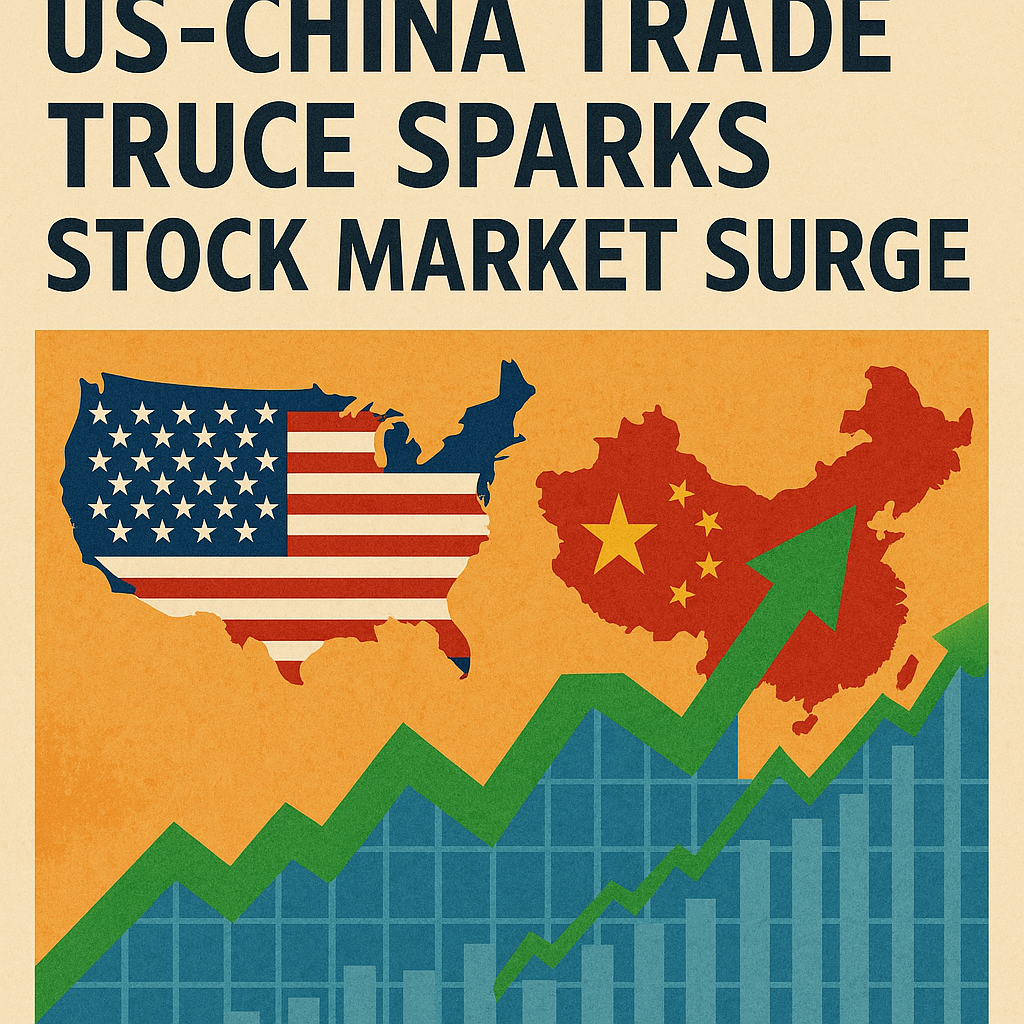US-China Trade Truce Sparks Stock Market Surge
On May 12, 2025
Wall Street erupted in celebration as the Dow Jones Industrial Average soared over 1,000 points, driven by a surprise US-China agreement to slash tariffs and ease a bruising trade war. The deal, brokered over a weekend in Geneva, marks a dramatic de-escalation in tensions that had threatened to plunge the global economy into recession. But with the agreement lasting just 90 days, is this a lasting breakthrough or a temporary reprieve? Let’s unpack the deal, its impact, and what it means for investors.
A Breakthrough in the Trade War
The US and China, the world’s two largest economies, agreed to cut “reciprocal” tariffs by 115 percentage points for an initial 90-day period. This reduces US tariffs on Chinese goods from a staggering 145% to 30% (including a 20% levy tied to fentanyl imports) and Chinese tariffs on US goods to 10%. The talks, led by US Treasury Secretary Scott Besant, US Trade Representative Jamieson Greer, and Chinese Vice Premier He Lifang, also established a mechanism to prevent future tariff hikes, signaling a commitment to dialogue over confrontation.
The agreement follows months of escalating tensions. On April 2, 2025, President Donald Trump’s “Liber

ation Day” policy imposed a 10% tariff on nearly all US imports, with Chinese goods facing up to 145%. China retaliated with 125% tariffs, nearly halting bilateral trade. The fallout was severe: US consumer sentiment plummeted, imports from China dropped 75–80%, and economists warned of a 60% recession risk. The de-escalation, described as “tough but respectful” by Besant, offers relief to businesses and consumers battered by price hikes and supply chain chaos.
Wall Street’s Jubilant Response
The stock market’s reaction was swift and enthusiastic. The Dow climbed 975 points (2.3%), the S&P 500 rose 2.7%, and the Nasdaq Composite jumped 3.7% on Monday. Tech stocks, battered by the trade war due to their reliance on Chinese manufacturing, led the charge. Apple surged 7%, Tesla gained 7.7%, Nvidia rose 5.1%, Amazon climbed 8%, and Intel added 4.1%. Luxury goods makers like Hermes (+4%) and LVMH (+7%) also rebounded, reflecting renewed confidence in global trade.
Posts on X captured the excitement, with users reporting the Dow’s 1,000-point surge and attributing it to the tariff cuts. The rally erased losses from Trump’s April tariff announcements, though stocks remain below their February 2025 peaks. Safe-haven assets took a hit, with gold dropping 3.9% and the Japanese yen falling 1.5%, while US Treasury yields climbed above 4.45%, signaling a shift to riskier assets. As Deutsche Bank strategist Henry Allen noted, the market’s resilience and policy shift reduce recession risks, boosting investor optimism.

Why the Deal Matters
The trade war’s toll was undeniable. US imports from China fell 21% in April 2025, and shipments to US ports dwindled, reminiscent of pandemic-era disruptions. Corporate America, from tech giants to automakers, faced soaring costs, with Ford and GM warning of billions in losses. Consumers, already weary from inflation, braced for shortages and higher prices. The tariff cuts offer a lifeline, potentially stabilizing supply chains and easing inflationary pressures.
The agreement also reflects a pragmatic shift. Trump, who once claimed zero trade with China strengthened the US, now emphasizes a “fair deal.” Besant’s earlier warnings about the unsustainability of high tariffs, echoed in April, appear to have gained traction. The deal aligns with recent trade wins, like a UK agreement announced on May 8, which also lifted markets. For China, the truce supports its struggling export sector, though both sides face pressure to deliver a more permanent solution.
Risks and Uncertainties
While the market cheers, caution is warranted. The 90-day timeframe makes this a temporary truce, and tariffs remain higher than pre-Trump levels. If negotiations falter, Trump has hinted at raising tariffs again, though not to 145%. The US’s 30% tariff and China’s 10% levy could still strain trade, and the fentanyl-related levy adds complexity. Moreover, global growth forecasts remain subdued, with the IMF projecting a 2.8% expansion in 2025, down from 3.3% in 2024.
Investors must also navigate broader uncertainties. Trump’s attacks on Federal Reserve Chair Jerome Powell and ongoing tariff investigations into semiconductors and pharmaceuticals could reignite volatility. The market’s sensitivity to trade news—evident in a 2,200-point Dow drop on April 4 and a historic rally on April 9—underscores the stakes. As UBS’s Solita Marcella warned, swings will persist until trade policy clarifies.
What’s Next for Investors?
The US-China trade truce is a welcome reprieve, but it’s not a cure-all. Investors should capitalize on the rally, particularly in tech and consumer goods, but maintain diversified portfolios to hedge against volatility. Monitoring trade talks, set to resume in weeks, will be critical. Check platforms like CNBC or Bloomberg for real-time market updates, and follow @cnnbrk on X for breaking news. With tariffs still in play and global growth sluggish, a balanced approach—mixing stocks, bonds, and safe-havens like gold—remains prudent.
The road to a lasting US-China trade deal is long, but for now, Wall Street is savoring the moment. Whether this marks the end of the trade war or a brief pause, one thing is clear: in the world of trade and markets, expect the unexpected.
Get WordPress help, plugins, themes and tips at MachoThemes.com

Ohhh really